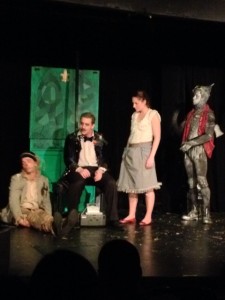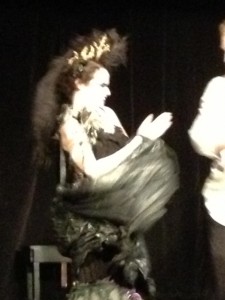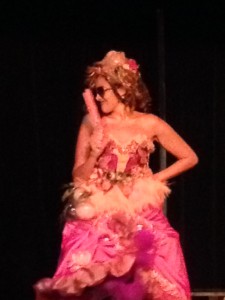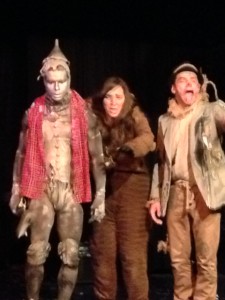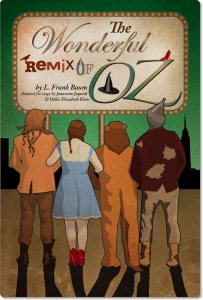 Date: August 17, 2013
Date: August 17, 2013
Venue: 13th St. Repertory Theatre
Review and photos by Dawoud Kringle
In the small, out of the way, and comfortable 13th Street Repertory Theatre, an audience of Saturday evening revellers and aficionados gathered for The Wonderful Remix of Oz (directed and adapted for stage by Haberdasher Theatre‘s Hollie Klem and Jeanette Jaquish). The very name promised an unorthodox comedic romp into an urban retelling of the classic; and a lot of fun. This was a promise they kept.
One of the pre-show announcements was that if you found anything under your seat, you were part of the show. The draftees from the audience would, on a musical cue, have to blow soap bubbles from the bottle they were given. Regrettably, only a few people who were selected by random chance to participate in this element of enforced recreation would muster the gumption to do this, and more often than not missed their cues. But, they were not professionals, like the actors on the stage; so this oversight may be forgiven.
Thank Allah I found nothing under my seat; or I would have had difficulty taking notes to write this review (I probably would have just moved it under someone else’s seat. But I digress).
The show opened with an argument between Miss Gully (Pamela Karp, who also played the Wicked Witch of the West Side) and the Professor (Matt Giroveanu, who also played the Wizard); a vacuum cleaner salesman. The shrewish, ill tempered, and doubtless sexually repressed Miss Gully took a particular dislike to Toto (a.k.a Toto-The-Dog, whose non-presence forced the audience to visualize the diminutive canine, as a trained dog was doubtless outside the reaches of the company’s budget), and threatened Auntie Em (Amy Lee Sanchez, who also played Glinda) with a lawsuit if they didn’t send the dog away. This inspired the innocent and kind hearted Dorothy (Jennifer Michaels, who carried the iconic character wonderfully without succumbing to the temptation of using Judy Garland’s performance as a template) to run away to The Big Apple.
A sudden tornado and nightmare sequence propelled Dorothy to Oz (this was very imaginatively produced in a style reminiscent of kabuki theatre.)
After a meeting with the bizarre and potentially threatening characters of Looney Blockhead (Chenana Manno, who also played a citizen of Emerald City, and a Monkey), Looney Mermaid (Taylor Zito, who also played the Apple Tree, and a Monkey), and Looney Snake (Jacob Corbett, who also played a citizen of Emerald City, and a Monkey), Dorothy met the punk styled, streetwise, yet soft hearted under the rough exterior Glinda, a good witch, whose wardrobe was clearly the result of having raided a vintage clothing store. After a slight misunderstanding involving a bright pink hand gun, she introduced her to the strange land she was in, and thanked her for inadvertently killing the Wicked Witch of the East Side with the house that fell on her. Of course, the Wicked Witch of the West Side (whose stage presence, by the way, was always powerful and scene stealing), while happy her older sister was dead, she didn’t like Dorothy one bit. Especially after Dorothy was burdened with the Ruby Slippers, powerful magical footwear the Wicked Witch coveted (which, if memory serves me, was later stolen by a citizen of Emerald City – the only spoiler of the ending you’re getting).
There was a veiled reference to this being a typical “chick story:” two women fighting to the death over a pair of shoes. But I digress.
As Dorothy’s travels to Oz progressed, she was shocked to meet the Scarecrow (Jeff Foley). It’s not every day one encounters an anthropomorphic and sentient bag of straw with the power of speech, and poor Dorothy was temporarily overcome by the awkwardness of the situation. Soon, however, they became travelling companions. Her introduction to Tin “Wood” Man (Alex Coelho) was preceded by an unpleasant encounter with Tree, in which the hapless heroine and her travelling companion were bombarded with plastic apples. The Tin Man, who needed rescuing from his rust induced catatonic imprisonment via the liberal use of an oil can, was a streetwise, tough Brooklynite who had been hurt by life, but decided to man up and face it. The action packed meeting with Lioness (Lindsay Arber), complete with “lions and tigers and vampire dust bunnies, oh my!” (no, I’m not explaining this one; you’ll have to see the play and figure it out yourself) was particularly entertaining.
The poppy field sequence introduced the Monkeys, who were given much more depth of character than the original movie. The poppies had their legendary effect; and the drugged delirium was explored in some depth.
Their entrance into Oz was colourful. The Gatekeeper was a modern 20-something in mannerisms, but was just as irritable and irritating as the original. Yet, Dorothy and Company were soon given a warm reception by the good citizens of Emerald City.
The meeting with the Wizard was dramatic and overblown in a delightful way. His dialogue/diatribe over the cheap Radio Shack microphone plugged into the beaten, second hand Crate guitar amp (deliberate low tech used to wonderful comedic effect) was flamboyantly vitriolic in a W. C. Fields/Vincent Price kind of way. The Wizard was as horrible and arrogant as he was ultimately superficial.
While Girovenau’s performance was excellent, the play’s only real flaw was the unveiling of the Wizard too soon (even though, let’s face it, we all know the story). We saw him preparing for Dorothy’s arrival. The “secret” of his identity as a mere mortal could have waited to be revealed when Dorothy and friends saw him for what he was. Perhaps they felt they wanted to give the Wizard more exposure and explore his character in more depth. But a long tacit insinuation, followed by a dramatic explosion, such as in “Waiting for Godot” or the Mr. Jenson character in the movie “Network” could have had a dominating and overwhelming psychological impact – even in a comedy.
The abduction of Dorothy by the Monkeys involved a brief fight sequence that evoked dance and faux martial arts; and was executed with wonderful agility. Dorothy had to fight with the Monkeys; and, alas, could not escape.
During Dorothy’s captivity, we learn the Monkeys were under a spell by the Wicked Witch of the West Side. They were slaves looking for freedom, which gave Dorothy hope. The Lioness, Scarecrow, and Tin Man, having followed the invisible Toto-The-Dog to the castle, broke in and overcame the Monkeys in a hilarious slow motion fight sequence. This, of course, led to Dorothy’s rescue (and while she went through all these life threatening and insane adventures, her innocence and goodness was never in any way diminished). The death of the Wicked Witch of the West Side – yes, the bucket of water, “I’M MELTING!!!”, etc, – hilarious and delightfully overacted in a manner perfectly suited to the play.
I will leave off descriptions of the rest if the play: further spoilers will never do.
The actors who were required to play more than one character transformed from one character to another with ease (rapid costume and makeup changes as well). Each performance was distinct and believable (despite them being weird fantasy characters in a comedic interpretation of an old classic). The distinction between each character was quite striking. For example Chenana Manno’s first character, Loony Blockhead, was sleazy and despicable; a man I would never turn my back on. As the Oz shopkeeper she was a flamboyant urbanite, and as Monkey she was a Jersey Shore “tough guy” who was always ready to do the Wicked Witch’s dirty work. All the while, making liberal use of an iPhone as a prop (Apple invadedOz!) as a lampoon of modern cyber culture.
The stage was bare. This lack of elaborate props or sets was indicative that the actors would carry the weight of the performance by their skill alone. Such is the test of an actor’s merit. The characters came in and out, changing the minimalist scenery while simultaneously acting. The transitions between scenes were very efficient and imaginative; and kept the pacing of the show unbroken. There was never a lull in the action, never a dull moment.
The music was a mix that underscored the action in a modern vernacular. Bits of classic tunes, snippets of songs more as suggestions of their originals, and loops and remixes of rock songs (i.e. Led Zeppelin’s “Immigrant Song” used when the Monkeys were dispatched to abduct Dorothy) created a vivid sonic image.
The Wonderful Remix of Oz is one of those plays that is done as a labor of love. In such projects, the mettle of true artistry is put to the test. Such performances are much more satisfying than a lot of what is sold as entertainment, because one is watching not only the finished product, but the creative process itself being tested under fire. And the minimal scenery not only inspired the audience to a stimulated imagination and inner mental imagery, but also threw the actor’s talents and performances into raw, sharp, relief. The value of this form of theater is immense; and everyone involved with The Wonderful Remix of Oz proved their worth beautifully.


